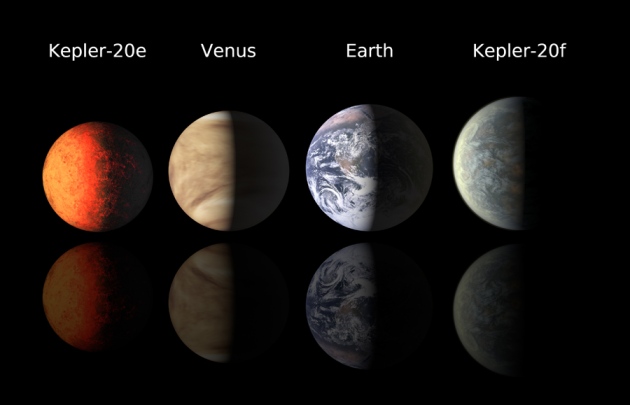New York – Two Earth-sized planets were discovered by scientists orbiting a star 950 light-years outside our solar system.
 The news brings many things to light.
One is planets from such a distance away are able to be detected by
the Kepler spacecraft, NASA's telescope which currently found several
dozens of Earth-sized planets. Another is the possibility of life
being present on the planet. Third is the features of the planet.
So far the planets, named Kepler-20e and Kepler-20f, possess a radius
.87 times and 1.03 times our planet respectively. Both seem to be
rocky and are the smallest of such planets orbiting a sun like ours
found so far. Kepler-20e has a six Earth-day orbit, Kepler-20f
orbits its star with a 20-day orbit. Nature magazine states neither
of them are in what's called “the habitable zone,” nor do they
spin on their axes. The scientists have yet to work out the planets'
densities, which will be done with instruments like the HARPS-North
radial-velocity spectrometer in the Canary Islands. It will be
revealed around April of 2012
The news brings many things to light.
One is planets from such a distance away are able to be detected by
the Kepler spacecraft, NASA's telescope which currently found several
dozens of Earth-sized planets. Another is the possibility of life
being present on the planet. Third is the features of the planet.
So far the planets, named Kepler-20e and Kepler-20f, possess a radius
.87 times and 1.03 times our planet respectively. Both seem to be
rocky and are the smallest of such planets orbiting a sun like ours
found so far. Kepler-20e has a six Earth-day orbit, Kepler-20f
orbits its star with a 20-day orbit. Nature magazine states neither
of them are in what's called “the habitable zone,” nor do they
spin on their axes. The scientists have yet to work out the planets'
densities, which will be done with instruments like the HARPS-North
radial-velocity spectrometer in the Canary Islands. It will be
revealed around April of 2012
Despite this news however, presently
humans would not be able to survive on either planet even if we were
able to travel there in a relatively short period of time due to
their temperatures. Kepler-20e is estimated to be 1,400 degrees Fahrenheit and 20f reaches 800.
This news comes on the heels of another
planet found with a surface more friendly to us, roughly about 72
degrees Fahrenheit, but too large to suggest life exists on its
surface. That planet is estimated to be 2.4 times the size of Earth
and possibly more like Neptune than Earth.
“Kepler can do things that no other
telescope can do,” says Jonathan Fortney, astronomer at the
University of California, Santa Cruz. He states the fact the two
planets are sandwiched between three larger planets spanning a size
spectrum from “super-Earths” to “mini-Neptunes” makes them
strange finds. David Charbonneau, a Harvard-Smithsonian Center
astronomer and co-author of the paper, stated “Different-sized
planets do not mingle in [our] solar system, but apparently in this
system they do.”
Update: Astronomers believe the planets were once gas giants that were stripped down after being swallowed by their swollen, aging parent. They also say they "are sure there is no life on these planets."
Update: Astronomers believe the planets were once gas giants that were stripped down after being swallowed by their swollen, aging parent. They also say they "are sure there is no life on these planets."
No comments:
Post a Comment